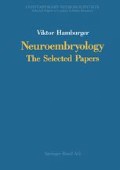Abstract
Did embryology and, more specifically, experimental embryology assist in the creation of the modern synthesis during the thirties and early forties, or, on the contrary, was it a retarding element? The major works that embody the modern synthesis by Huxley (1942), Dobzhansky, Fisher, Haldane, Mayr, Simpson, and Wright hardly mention embryonic development. This omission is somewhat strange because Huxley was sufficiently interested in growth and development to write two books on this topic: one on relative growth (1932), and a text of experimental embryology with de Beer (1934). His book on evolution clearly shows the dominance of Huxley the naturalist over Huxley the embryologist. Obviously, the modern synthesis had a strong foundation in Mendelian and population genetics and its mathematical treatment, in ecology, and in field studies of speciation. It could well afford to dispense with embryology, although its implications for genetics and evolution were recognized by the founders of the modern synthesis. Conversely, the contemporary leading books on experimental embryology, by Schleip (1929), Spemann (1936), and Weiss (1939), did not include considerations of evolution. The modern synthesis did not receive assistance from contemporary embryologists.
Access this chapter
Tax calculation will be finalised at checkout
Purchases are for personal use only
Preview
Unable to display preview. Download preview PDF.
References
Baltzer, F. 1940. Über erbliche letale Entwicklung und Austauschbarkeit artverschiedener Kerne bei Bastarden. Naturwissenschaften 23: 177–206.
Baltzer, F. 1952. Experimentelle Beiträge zur Frage der Homologie. Xenoplastische Transplantationen bei Amphibien. Experientia 8: 285–297.
Beadle, G., and B. Ephrussi. 1936. The differentiation of eye pigments in Drosophila as studied by transplantation. Genetics 21: 225–247.
Berrill, N. J., ed. 1939. First symposium on development and growth.
Boveri, Th. 1895. Über die Befruchtungs-und Entwicklungsfähigkeit kernloser Seeigel-Eier und über die Möglichkeit ihrer Bastardierung. Roux’s Archiv für Entwicklungsmechanik der Organismen 2: 394–443.
Caspari, E. 1933. Über die Entwicklung eines pleiotropen Gens bei der Mehlmotte, Ephestia kühniella. Roux’s Archiv für Entwicklungsmechanik der Organismen 130: 354–381.
Dalcq, A. 1949. L’apport de l’Embryologie causale au Probleme de l’Evolution. Portugaliae Acta Biologica, Serie A. Goldschmidt Volume, pp. 367-400.
Dalcq, A. 1951. Le Problème de l’Evolution, est-il près d’être résolu? Annales de la Société Royale zoologique de Belgique 82: 117–138.
Driesch, H. 1891. Entwicklungsmechanische Studien I: Der Wert der beiden ersten Furchungszellen in der Echinodermen-Entwicklung. Zeitschrift für wissenschaftliche Zoologie 53: 160–178.
Driesch, H. 1894. Analytische Theorie der organischen Entwicklung. Leipzig: Engelmann.
Goldschmidt, R. 1920. Die quantitativen Grundlagen von Vererbung and Artbildung. Roux’ Vorträge und Aufsätze 24.
Goldschmidt, R. 1927. Physiologische Theorie der Vererbung. Berlin: Springer.
Goldschmidt, R. 1935. Gen und Ausseneigenschaft. Zeitschrift für Induktive Abstammungs-und Vererbungslehre 69: 38–131.
Goldschmidt, R. 1940. The material basis of evolution. New Haven: Yale University Press.
Harrison, R. G. 1937. Embryology and its relations. Science 85: 369–374.
Huxley, J. S. 1932. Problems of relative growth. London: Methuen.
Huxley, J. S. 1942. Evolution: the modern synthesis. London: Allen and Unwin.
Huxley, J. S. and de Beer, G. R. 1934. The elements of experimental embryology. Cambridge: Cambridge University Press.
Kühn, A. 1936. Versuche über die Wirkungsweise der Erbanlagen. Naturwissenschaften 24: 1–10.
Kühn, A., E. Caspari, and E. Plagge. 1935. Über hormonale Genwirkungen bei Ephestia kühniella. Nachrichten von der Gesellschaft der Wissenschaften zu Gottingen 2: 1–30.
Lillie, F. R. 1927. The gene and the ontogenetic process. Science 66: 361–368.
Mayr, E. 1970. Populations, species, and evolution. Cambridge, Massachusetts: Harvard University Press.
Morgan, T. H. 1919. The physical basis of heredity. Philadelphia: Lippincott.
Morgan, T. H. 1934. Embryology and genetics. New York: Columbia University Press.
Roux, W. 1881. Der Kampf der Theüe im Organismus. Leipzig: Engelmann.
Schleip, W. 1929. Die Determination der Primitiventwicklung. Leipzig: Akademische Verlagsanstalt.
Schmalhausen, I. I. 1949. Factors of evolution. Philadelphia: Blakiston.
Spemann, H. 1924. Vererbung und Entwicklungsmechanik. Naturwissenschaften 12: 65–79.
Spemann, H. 1936. Experimentelle Beiträge zu einer Theorie der Entwicklung. Berlin: Springer. (1938 English translation: Embryonic development and induction. New Haven: Yale University Press.)
Spemann, H. 1943. Forschung und Leben, ed. F. W. Spemann. Stuttgart: Engelhorn.
Spemann, H. and O. Schotte. 1932. Über xenoplastische Transplantation als Mittel zur Analyse der embryonalen Induktion. Naturwissenschaften 20: 463–467.
Stern, C. 1954. Two or three bristles. American Scientist 42: 213–247.
Waddington, C. H. 1957. The strategy of the genes. London: Allen and Unwin.
Weismann, A. 1893. The germ-plasm: a theory of heredity, trans. W. N. Parker and H. R. Ronnfeldt. London: Walter Scott.
Weiss, P. 1939. Principles of development. New York: Holt.
Wilson, E. B. 1925. The cell in development and heredity, 3d ed. New York: Macmillan.
Wright, S. 1934. Genetics of abnormal growth in the guinea pig. Cold Spring Harbor Symposium on Quantitative Biology 2: 137–147.
Rights and permissions
Copyright information
© 1990 Springer Basel AG
About this chapter
Cite this chapter
Hamburger, V. (1990). Embryology and the Modern Synthesis in Evolutionary Theory. In: Neuroembryology. Birkhäuser, Boston, MA. https://doi.org/10.1007/978-1-4899-6743-5_18
Download citation
DOI: https://doi.org/10.1007/978-1-4899-6743-5_18
Publisher Name: Birkhäuser, Boston, MA
Print ISBN: 978-1-4899-6745-9
Online ISBN: 978-1-4899-6743-5
eBook Packages: Springer Book Archive

